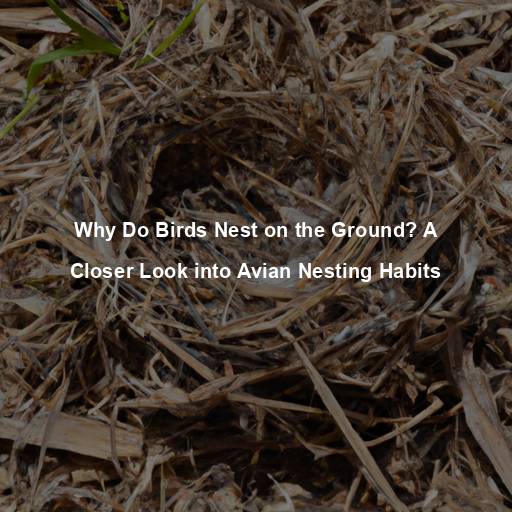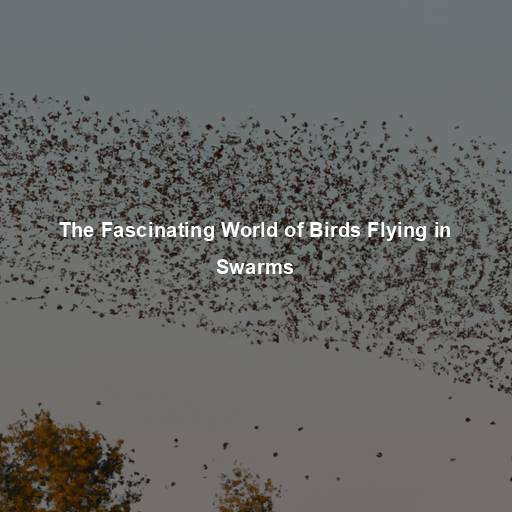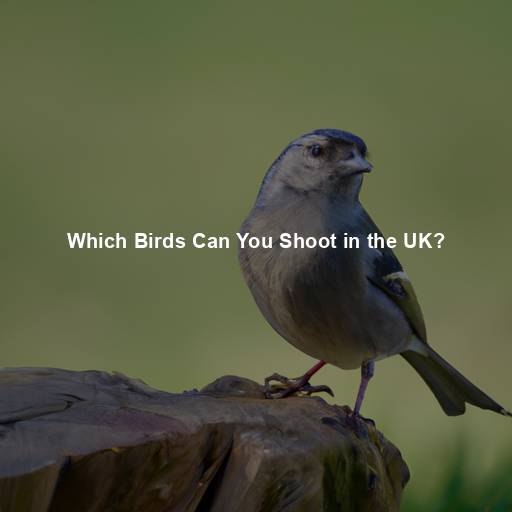Why Do Birds Nest on the Ground? A Closer Look into Avian Nesting Habits
Last Updated on July 16, 2023 by Evan
Contents [hide]
- 1 Understanding the Fascinating World of Avian Nesting
- 1.1 The Ground-Nesting Phenomenon: An Unconventional Choice
- 1.2 The Advantages of Ground Nesting
- 1.3 Environmental Factors Influencing Ground Nesting
- 1.4 Notable Ground-Nesting Bird Species
- 1.5 Conservation and Challenges for Ground-Nesting Birds
- 1.6 The Wonders of Avian Adaptations
- 1.7 Burrowing Owls (Athene cunicularia)
- 1.8 Megapodes (Family Megapodiidae)
- 1.9 Ground-Nesting Waterfowl
- 1.10 Penguins (Family Spheniscidae)
- 2 The Role of Predation in Ground-Nesting Success
- 3 The Evolutionary Significance of Ground Nesting
- 4 The Delicate Balance: Conservation of Ground-Nesting Birds
- 5 A Final Appreciation for Ground-Nesting Birds
- 6 FAQs – Why Birds Nest on the Ground
- 6.1 Why do some birds choose to nest on the ground?
- 6.2 Which bird species are known to nest on the ground?
- 6.3 Are there any disadvantages to nesting on the ground?
- 6.4 How do ground-nesting birds protect their nests?
- 6.5 Do all birds that nest on the ground build typical nests?
- 6.6 Is it safe to approach or disturb a ground nest?
Understanding the Fascinating World of Avian Nesting
Birds are remarkable creatures that never cease to amaze us with their unique behaviors and adaptations. One of the most intriguing aspects of bird behavior is their nesting habits. While many bird species build their nests in trees or other elevated locations, there are some notable exceptions. In this article, we delve into the question of why some birds choose to nest on the ground instead of up in the trees.
The Ground-Nesting Phenomenon: An Unconventional Choice
Bird nests have long intrigued nature enthusiasts and scientists alike. We typically imagine these intricate structures high up in the treetops or well-hidden within the foliage. But hold on to your feathers, because some birds have taken an unexpected turn and chosen the ground as their nesting spot! This puzzling behavior has caused quite a flutter in the scientific community, as experts seek to unravel the mysteries behind Mother Nature’s unconventional choices.
The Advantages of Ground Nesting
Nestling amidst the earthly embrace, ground-nesting birds possess the audacious ability to harness the unique advantages inherent to their chosen abode. Despite the inherent perils, these avian trailblazers have defied convention, adorning the soil with their carefully crafted sanctuaries. An enigmatic blend of instinct and unwavering adaptability, these feathered adventurers have honed their innate prowess to exploit the untapped potential that lies within the terrestrial realm. From evading predators with elusive precision to capitalizing on the abundant resources that permeate the ground, these intrepid aviators unravel the enigma of existence with their bewildering splendor.
Camouflage and Concealment
When it comes to protecting their precious offspring, ground-nesting birds have truly mastered the art of blending in. They’ve got this incredible ability to seamlessly disappear into their surroundings, like some kind of avian chameleon. It’s no wonder that predators are left perplexed, scratching their heads and wondering where on earth these elusive nests could be hiding. But hey, that’s nature for you – full of burstiness and endless surprises!
Accessibility and Ease of Construction
For some bird species, constructing a nest high up in the trees may not be a feasible option. Ground nesting offers a practical alternative, as it requires less energy and resources compared to building an elevated nest. By utilizing materials found on the ground, such as leaves, twigs, and moss, these birds can create a suitable nesting environment without the need for complex construction.
Brood Parasitism Defense
Ground-nesting birds have also developed specific adaptations to defend against brood parasites, such as the notorious cuckoo bird. By nesting on the ground, these birds can more effectively protect their nests from intruders. The open nature of the ground makes it easier for adult birds to detect and ward off potential threats, ensuring the survival of their own offspring.
Environmental Factors Influencing Ground Nesting
Nestling upon the earth, avian species delight in an array of advantages that buoy their decision to eschew treetop dwellings. Yet, behold! In this intricate tapestry of avian life, environmental factors, like enigmatic puzzle pieces, interweave their mysterious influence. Come, wander with us and unravel the enigma of why some birds, winged wonders of the skies, choose to nest upon the terrestrial canvas below.
Habitat Availability
In certain habitats, such as open grasslands, deserts, or tundra, trees and shrubs may be scarce or absent. Ground nesting becomes a necessity for bird species residing in these environments, as there are limited options for alternative nesting sites. These birds have adapted to thrive in these unique habitats, utilizing the ground as a safe and suitable place to raise their young.
Temperature Regulation
Ground nesting can also provide temperature regulation benefits for bird eggs and nestlings. The ground acts as a thermal insulator, helping to maintain a stable temperature within the nest. This can be particularly advantageous in environments with extreme temperature fluctuations, as the ground provides a more constant and suitable environment for incubation and early development.
Notable Ground-Nesting Bird Species
Birds have taken the remarkable decision to venture into ground nesting, defying conventional norms and adopting a strategy that leaves us awe-struck. From the secluded corners of forests to the vast plains of grasslands, these diverse avian species have all sought refuge in the earth itself. Join us as we delve into the perplexing world of ground nesting, exploring the astonishing choices made by these feathered wonders. Brace yourself for a burst of intriguing stories that will make you question everything you thought you knew about bird behavior.
Killdeer (Charadrius vociferus)
Have you ever come across the enigmatic Killdeer, that elusive ground-dwelling bird native to North America? With its understated yet intricate nesting habits, this avian artist crafts its humble abode on the unforgiving terrain of gravel and sand patches. Cunningly blending into its surroundings, the Killdeer’s nest is a marvel of camouflage. But what truly sets this species apart is its unbelievable knack for pulling off a one-of-a-kind distraction act, luring would-be predators away from its precious offspring by feigning injury.
Ostrich (Struthio camelus)
Have you ever wondered how the Ostrich, the master of ground nesting, takes things to a whole new level? Brace yourself for a burst of awe-inspiring facts! Being the largest living bird species, the Ostrich has a knack for constructing colossal nests, aptly called “scrapes,” just by scratching out shallow depressions in the ground. These remarkable nests can reach mind-boggling diameters, spanning several meters, and serve as bustling incubation hubs where the Ostrich community comes together.
Piping Plover (Charadrius melodus)
The enchanting Piping Plover, a dainty shorebird gracing the sandy shores of North America, finds solace in constructing its fragile nests amidst the warm embrace of beaches. Perched lightly on shallow depressions, these nests often nestle near majestic dunes and verdant vegetation. An exquisite blend of sandy hues adorns its eggs, making them nearly indistinguishable from the surrounding beach, a masterstroke of nature’s artistry. Such impeccable camouflage underscores the urgency of relentless conservation efforts, as we strive to safeguard the vulnerable nesting abodes of these transient beings.
Conservation and Challenges for Ground-Nesting Birds
Ground-nesting birds, with their remarkable nesting strategy, have triumphed amidst a perplexing array of challenges that loom over their very survival. The human hand, with its unintended consequences of habitat destruction, disruptive activities, and the encroachment of introduced predators, casts a shadow of uncertainty over their nesting success. To secure the delicate equilibrium of their existence, conservation endeavors that safeguard their precious habitats and ignite a spark of awareness about the boundless significance of these avian marvels become imperative.
The Wonders of Avian Adaptations
From the majestic heights of the treetops to the humble expanse of the ground, birds never fail to bewilder us with their extravagant array of behaviors and adaptations. Nesting, a primal act of survival and procreation, takes on a whole new level of intrigue when certain species opt for the terrestrial haven of the earth. Why do these winged wonders make this unconventional choice? By unraveling the mysteries behind their ground-dwelling tendencies, we unlock the secrets to their tenacity and marvel at the wonders of the avian world.
Burrowing Owls (Athene cunicularia)
Burrowing Owls have taken ground nesting to another level by utilizing old burrows dug by small mammals, such as prairie dogs. These charismatic owls often decorate the entrance of their burrows with an assortment of objects, including feathers, bones, and dung. This behavior not only adds personality to their nests but also serves as a visual deterrent to potential intruders.
Megapodes (Family Megapodiidae)
Imagine a world where birds defy convention and embrace the extraordinary. Enter the enigmatic realm of megapodes, these mysterious creatures, also known as mound-builders, have woven a perplexing web of nesting strategies that will leave you in awe. Rather than following the well-trodden path of traditional nests, they harness the power of nature’s ultimate drama – the heat generated by decaying organic matter. Yes, you read that right!
Ground-Nesting Waterfowl
Nestled near shimmering bodies of water, Mallards and Canada Geese display their unconventional nesting approach with bursts of audacious determination. Opting to lay their eggs on the terra firma, these avian pioneers fashion shallow depressions within dense vegetation or open expanses, perplexing traditional notions of safety. In this paradoxical choice, they seem to dance with uncertainty, simultaneously embracing the tantalizing allure of nourishment in the nearby aquatic realms while guarding against lurking predators. Their perplexing nesting strategy defies expectations, leaving us captivated by the enigmatic nature of their calculated decisions.
Penguins (Family Spheniscidae)
Although not strictly ground-nesting birds, penguins deserve a mention due to their unique nesting habits. These flightless birds construct their nests, known as “scrapes,” on the rocky or sandy ground of their breeding colonies. Penguins typically lay one or two eggs, which are incubated by both parents. The scrape nests provide a secure environment for the eggs and the subsequent rearing of the chicks.
The Role of Predation in Ground-Nesting Success
Ground-nesting birds face a constant battle against the perils of predation. From cunning mammals to stealthy snakes and even opportunistic birds, their precious eggs and vulnerable hatchlings are always at stake. Nevertheless, these resilient avian creatures have developed an array of cunning strategies to outsmart their would-be predators and ensure the survival of their young. It’s a fascinating game of survival, where every move counts and the stakes are high for these ground-bound nesters.
Ground-nesting birds have adopted an unconventional nesting strategy by choosing to build their nests on the ground instead of in trees. This behavior offers a range of advantages, including increased camouflage and concealment, easier accessibility and construction, and improved defense against brood parasites. Environmental factors such as habitat availability and temperature regulation also influence the decision to nest on the ground. Despite facing challenges from predation and habitat destruction, conservation efforts can help to protect these extraordinary birds and ensure their survival.
Vigilance and Nest Defense
In the realm of avian parenting, ground-nesting birds truly take vigilance to new heights. With an unwavering gaze, they continuously scout their surroundings, ever watchful for encroaching dangers. These feathered protectors have mastered the art of deception, employing a range of tactics such as emitting alarm calls, feigning injury, and even engaging in elaborate distraction displays to divert predators from their precious nests. Take the fascinating Killdeer, for instance, their performance knows no bounds as they simulate a broken wing to lead cunning predators astray from their defenseless offspring.
Camouflage and Nest Placement
The natural camouflage of ground nests plays a crucial role in reducing the likelihood of predation. Birds carefully choose nesting sites that blend with the surrounding environment, making it harder for predators to detect their nests. The use of materials that match the colors and textures of the habitat further enhances the effectiveness of camouflage.
Nest Site Selection
Ground-nesting birds often select nest sites strategically to minimize predation risks. They may choose locations with good visibility, allowing them to detect approaching predators early. Nesting near water bodies can also provide an advantage, as it creates additional barriers for potential predators and increases the chances of detecting their presence.
The Evolutionary Significance of Ground Nesting
The world of avian species holds fascinating tales of adaptation and survival. One such marvel lies in the adoption of ground nesting by certain birds, an extraordinary strategy tailored to overcome the challenges of their unique habitats. It is mesmerizing to witness how this behavior has independently evolved in various lineages, showcasing the ingenuity of Mother Nature in crafting solutions to diverse environmental demands. This adaptability, ultimately, has played a pivotal role in the thriving success and diversity of our feathered friends across the globe.
The Delicate Balance: Conservation of Ground-Nesting Birds
Preserving the delicate ecosystem that shelters our beloved ground-nesting birds has never been more paramount. The pressing need arises as we grapple with the disheartening destruction and disintegration of their natural havens, triggered by relentless urbanization and the encroachment of unfavorable agricultural practices. Take heart, though, for nestled within the chaos lies hope. By implementing innovative and strategic conservation strategies, we can raise a resilient shield against the relentless march of non-native predators and, against all odds, safeguard the future of these remarkable species.
Habitat Preservation and Restoration
In today’s ever-changing world, the preservation and restoration of habitats for our beloved ground-nesting birds has become an urgent endeavor. By safeguarding the diverse ecosystems they call home – from the sprawling grasslands to the serene wetlands and even the rugged coastal areas – we are embracing the interconnectedness of our natural world. And let us not forget the importance of establishing buffer zones and wildlife corridors, ushering these feathered creatures through the intricate maze of fragmented habitats, ensuring they can seek out their perfect nesting spots without a hitch. So, let us embark on this perplexing yet vital journey, where bursts of action and dedication pave the way towards a brighter future for our avian friends.
Predator Control and Management
In certain regions where foreign predators loom menacingly, taking precautionary measures to control their population can prove beneficial in curbing attacks on ground-nesting avian species. Such interventions may entail the elimination or regulation of invasive creatures that hamper nesting triumph. Nonetheless, it is of utmost importance to thoroughly contemplate the possible ecological consequences and adhere to scientifically-sound and ethically-bound strategies.
Public Awareness and Education
Raising awareness about ground-nesting birds and their importance is crucial for their conservation. Educating the public, landowners, and policymakers about the unique nesting habits and ecological roles of these birds can foster positive attitudes and actions towards their protection. Promoting responsible land management practices and minimizing disturbance in nesting areas are vital steps towards ensuring their survival.
A Final Appreciation for Ground-Nesting Birds
As our journey through the enigmatic world of ground-nesting birds draws to a close, we can’t help but marvel at the awe-inspiring array of adaptations and tactics these remarkable creatures possess. With their mastery of disguise and unwavering commitment to protect their nests, these birds have truly embraced the challenges of their chosen homes. Through their nesting practices, we are granted a tantalizing glimpse into the harmonious dance between these avian marvels and the ever-evolving landscapes they call their own.
Let us continue to marvel at the wonders of ground-nesting birds and work together to protect their habitats and ensure the preservation of these extraordinary creatures. With concerted conservation efforts and public awareness, we can make a positive impact and secure a future where ground-nesting birds continue to enchant us with their resilience and beauty.
FAQs – Why Birds Nest on the Ground
Why do some birds choose to nest on the ground?
There’s something truly captivating about birds that choose to nest on the ground. The reasons behind this peculiar behavior are as diverse as the species themselves. One intriguing motive is the concept of self-preservation – by hunkering down amidst their surroundings, these brave avian souls successfully evade the watchful eyes of predators and nest infiltrators. Moreover, the ground becomes a natural fortress, as the birds make clever use of lush foliage or rugged terrains as their defensive shields. The depth of their survival instincts continues to astound and perplex us.
Which bird species are known to nest on the ground?
Several bird species have adapted to nesting on the ground. Examples include the Killdeer, a small plover known for its ground-nesting habits, and the Common Nighthawk, a nocturnal bird that lays its eggs directly on the ground. Other ground-nesting birds include some shorebirds, waterfowl species like ducks and geese, as well as certain birds of prey such as the Burrowing Owl. These species have evolved specific characteristics that make ground nesting a suitable choice for them.
Are there any disadvantages to nesting on the ground?
Choosing to nest on the ground may seem like a clever move for birds, but it’s not all sunshine and rainbows. Sure, there are perks, but there are also some troubling downsides. One of the biggest headaches for ground-nesters is dealing with pesky predators who can’t resist the tasty treat of eggs or chicks. And let’s not forget about the unpredictable powers of Mother Nature – those ground nests are at a higher risk of getting flooded or accidentally trampled by reckless humans or wandering livestock. All these factors combine to make life a bit more precarious for our feathered friends, with higher chances of nest failure compared to their lofty counterparts nesting in trees and bushes.
How do ground-nesting birds protect their nests?
Ground-nesting birds employ various adaptations and behaviors to protect their nests and offspring. For instance, some species use distraction displays, where they feign injury or weakness, to divert predators away from the nest and lure them to a different location. Additionally, birds may select nesting sites that provide natural camouflage, such as areas with similar-colored vegetation or surroundings that match their plumage. They may also position their nests near water bodies or areas with dense vegetation, which can act as physical deterrents for predators.
Do all birds that nest on the ground build typical nests?
Ground-nesting birds have their own unique way of creating homes for their eggs. Unlike their tree-dwelling counterparts, some species, like the Killdeer, opt for simplicity by crafting low-profile scrapes in the earth, adorned with twigs, pebbles, or leaves. While these basic depressions may not offer the same level of protection as elaborate nests, other ground-nesting birds employ slightly more intricate techniques, incorporating materials like feathers, grass, or even mud. Although these nests may not rival the complexity of those found in trees or shrubs, they serve their purpose in providing a safe haven for their precious eggs.
Is it safe to approach or disturb a ground nest?
When it comes to ground nests, we must tread lightly, for they are delicate and easily disrupted. These humble abodes are already at a disadvantage compared to their high-rise counterparts. A simple step too close can trigger a wave of distress for the adult birds, pushing them to relinquish their precious offspring. Not to mention, a random predator may stumble upon the hidden sanctuary, putting the vulnerable nestlings in grave danger. In these situations, it’s best to maintain a safe distance, perhaps utilizing binoculars to satisfy our curiosity without causing harm.







